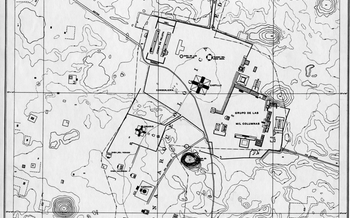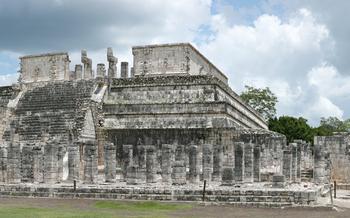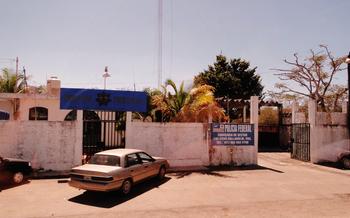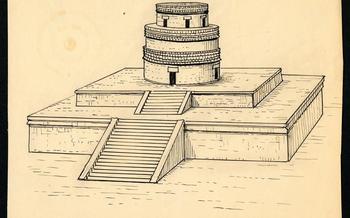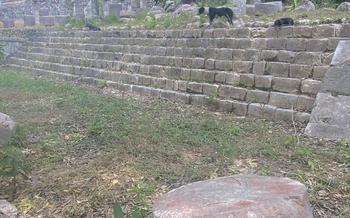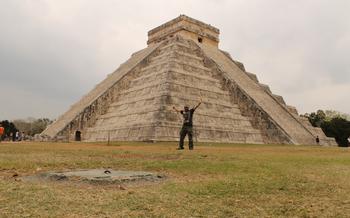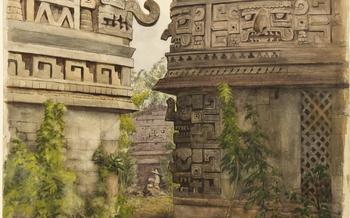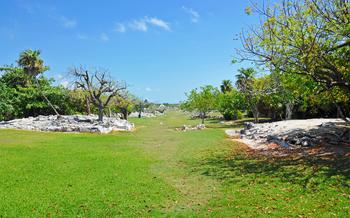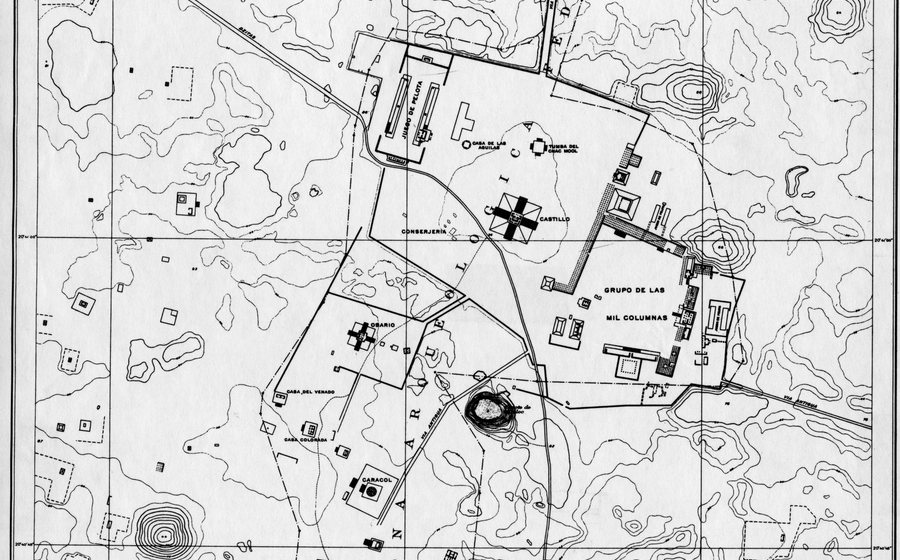
Cenote Chaak Tun
- Chichen Itza and the Cenote Chaak Tun
- History and Cultural Significance
- Photography Tips
- Cenote Chaak Tun vs. Other Cenotes
- Accessibility and Facilities
- Off-the-Beaten-Path Experience
- Ecological Importance of Cenotes
- Cenote Etiquette: Respecting the Natural and Cultural Heritage
- Planning Your Visit
- Nearby Attractions
- Budget Tips
- Insider Tip: Unveiling the Hidden Gem of Cenote X'Kekén
Chichen Itza and the Cenote Chaak Tun
Chichen Itza, the ancient Mayan city in the Yucatan Peninsula of Mexico, is a renowned UNESCO World Heritage Site that attracts millions of visitors each year. The city is home to iconic structures such as the Pyramid of Kukulcan, known as El Castillo, the Temple of the Warriors, and the Great Ball Court. Alongside these architectural marvels, Chichen Itza boasts a natural wonder that is equally mesmerizing - the Cenote Chaak Tun. Located just a short walk from the main archaeological zone, this cenote offers visitors a refreshing respite from the tropical heat and a chance to connect with nature's beauty.
The Cenote Chaak Tun, meaning "well of the rain god" in the Mayan language, is a subterranean sinkhole that leads to a vast underground chamber filled with crystal-clear fresh water. The cenote's depth reaches approximately 30 meters, and the water surface is surrounded by lush vegetation, creating a mystical and serene atmosphere. The cenote's name is a testament to its significance in Mayan culture, as the Mayans believed that cenotes were portals to the underworld and sacred places for communication with the gods.
History and Cultural Significance
The Cenote Chaak Tun holds great historical and cultural significance for the ancient Mayans. It was considered a sacred site where religious ceremonies and rituals took place. The Mayans believed that cenotes were portals to the underworld, known as Xibalba, and were closely associated with the water god Chaak. Offerings were made to Chaak in the form of jade, pottery, and other precious objects, which have been discovered during archaeological excavations at the cenote.
The cenote was also a crucial water source for the Maya. During the dry season, when surface water was scarce, the cenotes provided a reliable supply of fresh water for drinking, cooking, and irrigation. The Mayans constructed elaborate systems of underground tunnels and channels to divert water from the cenotes to their agricultural fields.
Archaeological discoveries at the Cenote Chaak Tun have unearthed a wealth of artifacts, including ceramic vessels, jade ornaments, and human remains. These artifacts provide valuable insights into the daily lives, rituals, and beliefs of the ancient Mayans who inhabited the region.
The cenote is also shrouded in legends and folklore. According to one legend, the cenote was once the home of a beautiful water goddess who would appear to young men who were pure of heart. Another legend tells the story of a young Mayan warrior who jumped into the cenote to escape capture by his enemies, only to emerge transformed into a powerful warrior with supernatural abilities.
Photography Tips
The Cenote Chaak Tun is a photographer's paradise, offering ample opportunities to capture stunning images. For the best results, plan your visit during the early morning or late afternoon hours when the sun's rays create beautiful reflections and dramatic lighting effects. Experiment with different camera settings, such as a slow shutter speed to blur the water's surface or a wide aperture to achieve a shallow depth of field. To capture reflections, position yourself at a low angle and use a polarizing filter to reduce glare. For underwater shots, consider using a waterproof camera or housing to capture the vibrant marine life and crystal-clear water. Remember to adjust your camera settings accordingly, as the light conditions underwater can be different from those above the surface.
Cenote Chaak Tun vs. Other Cenotes
The Cenote Cha relatively secluded location and limited number of visitors contribute to a more intimate and serene atmosphere. The cenote's depth and clarity are also notable, allowing for excellent snorkeling and diving opportunities. The rock formations and stalactites create a picturesque underwater landscape, making it a popular spot for underwater photography and exploration.
While other cenotes, such as Cenote Ik Kil or Cenote Dos Ojos, may be more popular and well-known, Cenote Chaak Tun provides a more authentic and off-the-beaten-path experience. The lack of crowds allows visitors to fully appreciate the natural beauty of the cenote without distractions. Additionally, the Cenote Chaak Tun is less developed, with fewer amenities and infrastructure, which can be appealing for those seeking a more rustic and adventurous experience.
Accessibility and Facilities
The Cenote Chaak Tun is generally accessible to visitors of all abilities. There are designated pathways and ramps for wheelchair users, ensuring easy movement throughout the site. Visitors can also take advantage of the changing rooms, showers, and restrooms available on-site for their convenience.
Food and beverage options are limited in the immediate vicinity of the cenote, so it's advisable to bring your snacks and drinks or plan to have a meal before or after your visit. There is a small restaurant located near the entrance that offers a selection of local dishes and refreshments.
Parking is available on-site for a small fee. The parking lot is spacious and can accommodate both cars and tour buses. Visitors are advised to arrive early, especially during peak season, to secure a parking spot.
Off-the-Beaten-Path Experience
In the midst of the bustling tourist crowds that flock to Chichén Itzá, the Cenote Chaak Tun offers a refreshing escape into tranquility. Unlike its more popular counterparts, this hidden gem remains relatively untouched, allowing visitors to immerse themselves in its serene beauty without the distractions of large groups.
The absence of crowds creates a palpable sense of peace and solitude, inviting you to connect with the natural surroundings and embrace the tranquility of the cenote. Whether you seek moments of contemplation or simply wish to bask in the serenity of nature, the Cenote Chaak Tun provides an ideal haven for relaxation and rejuvenation.
Moreover, the lack of crowds allows you to fully appreciate the cenote's pristine waters, vibrant aquatic life, and the intricate formations of stalactites and stalagmites that adorn its walls. Without the hustle and bustle of other visitors, you can truly immerse yourself in the cenote's enchanting ambiance and marvel at its natural wonders undisturbed.
Ecological Importance of Cenotes
Cenotes are vital components of the local ecosystem, playing a crucial role in the region's hydrology, biodiversity, and climate. The interconnected network of cenotes forms a unique aquifer system that provides a critical water source for both human communities and wildlife. Cenotes also serve as habitats for a diverse array of aquatic flora and fauna, including endemic species found nowhere else on Earth.
Protecting and preserving cenotes is essential for maintaining the delicate balance of the local ecosystem. Sustainable tourism practices and conservation efforts are crucial to ensure that these natural wonders remain pristine and accessible for generations to come. Visitors can contribute to the preservation of cenotes by respecting the environment, minimizing their ecological footprint, and supporting responsible tourism initiatives.
Cenote Etiquette: Respecting the Natural and Cultural Heritage
When visiting cenotes, it is crucial to prioritize the preservation of the natural environment and respect local customs. Here are some guidelines for responsible cenote exploration:
-
Avoid using harsh chemicals: Refrain from using sunscreen, insect repellent, or any other chemicals that may harm the delicate ecosystem. Opt for natural alternatives or apply products well before entering the water.
-
Dispose of waste properly: Bring a reusable water bottle and avoid single-use plastics. Dispose of any trash in designated containers or carry it out with you.
-
Respect the wildlife: Cenotes are home to diverse aquatic life. Refrain from touching, feeding, or disturbing the animals. Observe them quietly and from a distance to minimize disruption.
-
Be mindful of noise levels: Keep your voice down and avoid loud noises that could disturb the serene atmosphere. This also helps preserve the acoustic integrity of the cenote, allowing you to fully appreciate the natural soundscape.
-
Respect local customs and traditions: Cenotes hold cultural and spiritual significance for the Mayan people. Be respectful of their beliefs and traditions. If you encounter any rituals or ceremonies, observe quietly from a distance without interrupting.
Planning Your Visit
The best time to visit Chichen Itzá and the Cenote Chaak Tun is during the shoulder season, which falls between April and May and September and October. During these months, the weather is generally pleasant, with warm temperatures and fewer crowds. While the dry season (November to April) offers the most consistent sunny days, it also attracts the most tourists.
To make the most of your visit, plan to spend at least half a day exploring Chichen Itzá and the cenote. This will give you enough time to wander through the ancient ruins, swim in the refreshing waters of the cenote, and savor the serene atmosphere.
Pack light and comfortable clothing that you can easily change into after swimming. Don't forget your bathing suit, towel, and reef-safe sunscreen. If you're planning to take photos, bring a waterproof camera or a waterproof case for your phone.
To avoid the crowds, aim to arrive at Chichen Itzá early in the morning. You can either take a guided tour or explore the ruins on your own. Guided tours typically last around two hours and provide valuable insights into the history and significance of the site.
Once you've had your fill of history, head over to the Cenote Chaak Tun, which is located just a short walk from the ruins. There, you can relax, swim, and snorkel in the crystal-clear waters, surrounded by stunning natural beauty.
Nearby Attractions
Beyond the Cenote Chaak Tun, the region surrounding Chichen Itza offers a wealth of additional attractions. For those seeking further cenote experiences, the nearby Cenote Ik Kil and Cenote Hubiku are renowned for their stunning beauty and offer swimming, snorkeling, and diving opportunities.
Venturing beyond the realm of cenotes, history buffs can delve into the ancient Mayan culture at the Ek Balam ruins, which boast well-preserved structures and intricate carvings. The nearby city of Valladolid, with its colonial architecture and vibrant atmosphere, is also worth exploring.
Nature enthusiasts can immerse themselves in the verdant landscapes of the Rio Lagartos Biosphere Reserve, home to diverse wildlife, including flamingos, crocodiles, and sea turtles. The reserve offers guided boat tours and opportunities for hiking, birdwatching, and wildlife photography.
For a truly immersive experience, consider visiting a traditional Mayan village, such as Pisté or Xcalacoop, where you can learn about local customs, sample traditional cuisine, and witness the vibrant Mayan culture firsthand.
Budget Tips
Visiting Mexico and the Cenote Chaak Tun can be budget-friendly with some smart tips. Utilize local transportation options like buses or colectivos, which offer affordable rides. Pack your meals and snacks to save on dining costs, or explore the local markets for fresh produce and delicious street food. Look for discounts and promotions offered by tour operators or online platforms. Many restaurants in the area provide local dishes at reasonable prices. Bargaining at local markets can also lead to great deals on souvenirs and handicrafts. Embracing these budget-conscious practices will allow you to maximize your travel experience without breaking the bank.
Insider Tip: Unveiling the Hidden Gem of Cenote X'Kekén
Beyond the popular Cenote Chaak Tun, a hidden gem awaits discovery in the heart of the Yucatán Peninsula: Cenote X'Kekén. This secluded oasis, nestled amidst lush vegetation, offers an intimate and serene experience for those seeking tranquility.
With its crystal-clear waters and stunning rock formations, Cenote X'Kekén invites you to immerse yourself in its pristine beauty. Whether you prefer swimming, snorkeling, or simply basking in the sun, this cenote provides a peaceful haven away from the crowds.
To reach Cenote X'Kekén, venture off the beaten path and follow a local guide who can lead you through the dense jungle trails. The journey itself becomes an adventure, adding to the charm of discovering this hidden gem.
Remember to bring your snorkel gear to witness the vibrant underwater world of Cenote X'Kekén. The diverse aquatic life, including colorful fish and turtles, will captivate your senses as you explore the depths of this natural wonder.
As you float effortlessly through the crystal-clear waters, surrounded by towering stalactites and stalagmites, you'll feel a sense of awe and connection with nature. Cenote X'Kekén offers a unique opportunity to experience the beauty and tranquility of the Yucatán's hidden cenotes.
